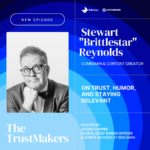By Allen Adamson, Co-founder & Managing Partner, Metaforce
Marketers have an undeniable tendency to chase the shiny new object. The latest social media platform, the most advanced AI-driven ad tech, and the buzziest experiential campaign—all are irresistible. However, Lou Aversano, Chief Marketing & Brand Officer of The Cigna Group, demonstrated in his acceptance speech for ANA’s Best B2B Marketer of the Year that the best approach isn’t necessarily the newest one. It’s the right one.
In a world obsessed with digital marketing, Aversano’s team chose an unexpected medium—long-copy print ads—to meet Cigna’s communication objectives. He wasn’t merely looking to follow the latest trends; he was looking for impact. And in this case, print delivered.
Aversano’s challenge was formidable. The Cigna Group’s pharmacy benefit business – Express Scripts by Evernorth – was engaged in a battle of perception, with pharmaceutical companies driving a well-financed narrative that positioned insurers as the villains in the healthcare debate. The media landscape was stacked against them. Rather than joining the noise with another flashy digital campaign, the Cigna team took a different approach—one rooted in clarity, intelligence, and respect for the audience’s ability to engage with facts.
The challenge in B2B marketing is that, more often than not, you are not just selling a product or service; you’re selling confidence in the company itself. That’s a far greater task. To illustrate this, Aversano leaned on a powerful piece of marketing history—the classic McGraw Hill ad from over 50 years ago. The ad, featuring a stern-looking businessman sitting in a chair, famously states:
> I don’t know who you are.
> I don’t know your company.
> I don’t know your company’s product.
> I don’t know what your company stands for.
> I don’t know your company’s customers.
> I don’t know your company’s record.
> I don’t know your company’s reputation.
> Now, what was it you wanted to sell me?
The message? Before you can sell anything, you must establish trust, and credibility. That’s exactly what Aversano sought to do for The Cigna Group.
Print, often dismissed as a relic of the past, proved to be the perfect vehicle for this message. The long-copy ads provided the space to articulate their value in a way that couldn’t be reduced to a soundbite. They allowed the company to challenge misconceptions with depth and nuance rather than trying to outshout the opposition. The results? A 44% increase in site visits, a 34% lift in brand favorability, and a noticeable disruption of an eight-year-long opposing campaign.
But Aversano’s lesson goes beyond the power of print. His real point is that effective marketing isn’t about the medium—it’s about the message. In his words, Cigna’s ads weren’t just about selling a product; they were about sharing a point of view, helping audiences make sense of the world on their terms, and advocating for truth in an era of disinformation.
This underscores a broader marketing truth: The best communication strategy isn’t dictated by what’s trendy but by what works. Podcasting didn’t kill radio, video didn’t kill print, and digital doesn’t always outperform traditional media. The right tool is the one that serves the strategy, not the other way around.
As Aversano put it, marketers must resist the temptation to blindly embrace the ‘versus’ mentality—digital versus print, new versus old. Instead, they must focus on crafting the most compelling, credible, and contextually appropriate message possible.
In an industry obsessed with the next big thing, perhaps the most powerful strategy simply embraces what works. Aversano’s approach reminds us that while marketing technology evolves, the principles of effective communication remain timeless. Whether through print, digital, or whatever comes next, the most successful brands are the ones that know who they are, what they stand for, and how to communicate that effectively.











